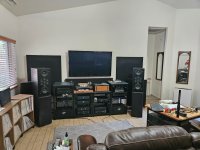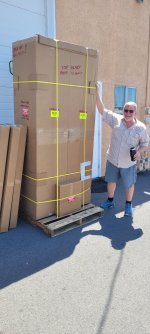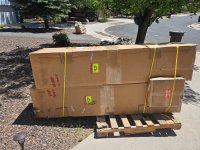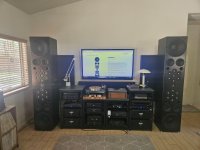Have been constructing Pass and Colburn phono pre, preamp, and monoblock amps for 6 years now. Began looking for a speaker that would be ideal for this combination and decided to try Tekton's new Ulfbehrt 15s. This thread is devoted to the process of acquiring and setting up these large speakers followed by some listening impressions.
No-one likes long posts and will divide the content into these categories:
No-one likes long posts and will divide the content into these categories:
- Pass/Colburn/Thatcher electronics – design and build
- Design, delivery, and install of the Ulf 15s
- Initial Listening
- Test for concert realism
- Conclusions
Last edited:
Pass/Colburn/Thatcher DIY builds
Colburn Pearl 3 Phono Preamp
My version uses matched transistors (eight 2SK170s from PunkyDawgs), 0.1% resistors, and dual linear bipolar PSUs – one for each circuit board. This is an exceptional pre and it is dramatically better than the retail pres it replaced (and all others I have heard – thanks, 6L6 for your considerablehelp in custom design).
Colburn BA2018 System Preamp
Wayne's brilliant design for a high-end preamp that benefits from matched JFets, dual linear bipolar PSUs, 0.1% resistors, Goldpoint attenuators and Grayhill selectors – all with point-to-point 22awg solid copper wire. This Colburn guy is crazy good...
Classic Aleph 30 – clone design byThatcher of Pass's famous SEPP monoblocks
Thatcher adds trimpots for DC offset, AC Gain, and bias. Found, by comparison, that this SEPP amp beats all others I have tried (Class A, 300B, A/B, etc.) and so am using twoAleph monoblocks per channel for bi-amp purpose.
This 3-stage system uses a separate PCU for each channel/amp level and a discrete linear PSU for each board.The actual system is shown in the Jpeg below. This first incarnation spoke to Tekton Double Inpact speakers as shown below and was so successful it made you want to listen to your favorite media choice.
Decided to go towards a larger speakerwith bi-amp capabilities for orchestral play and, so...
Colburn Pearl 3 Phono Preamp
My version uses matched transistors (eight 2SK170s from PunkyDawgs), 0.1% resistors, and dual linear bipolar PSUs – one for each circuit board. This is an exceptional pre and it is dramatically better than the retail pres it replaced (and all others I have heard – thanks, 6L6 for your considerablehelp in custom design).
Colburn BA2018 System Preamp
Wayne's brilliant design for a high-end preamp that benefits from matched JFets, dual linear bipolar PSUs, 0.1% resistors, Goldpoint attenuators and Grayhill selectors – all with point-to-point 22awg solid copper wire. This Colburn guy is crazy good...
Classic Aleph 30 – clone design byThatcher of Pass's famous SEPP monoblocks
Thatcher adds trimpots for DC offset, AC Gain, and bias. Found, by comparison, that this SEPP amp beats all others I have tried (Class A, 300B, A/B, etc.) and so am using twoAleph monoblocks per channel for bi-amp purpose.
This 3-stage system uses a separate PCU for each channel/amp level and a discrete linear PSU for each board.The actual system is shown in the Jpeg below. This first incarnation spoke to Tekton Double Inpact speakers as shown below and was so successful it made you want to listen to your favorite media choice.
Decided to go towards a larger speakerwith bi-amp capabilities for orchestral play and, so...
Attachments
Tekton Ulfbehrt 15s – design,delivery, and install
The first generation Ulfbehrt speakers used 12 inch woofers and Eric's patented 15 dome radiating hybrid midrange matrix array. The Ulf 15s expand the woofer size with proprietary 15 inch woofers from Eminence and add a beryllium centertweeter. Crossover upgrades are available as you like and my choices were Solen caps and Jentzen coils. The speaker design employs an expanded D-Apollito array of woofer, low mid, high mid, tweeter, then supertweeter. The central supertweeter is 41 inches from the ground –exactly at ear height when seated. Brilliant because there are thesame number of speakers above the ear as there are below.
These take a while to build; mine were 6 weeks. Once finished, they are shipped to you by truck. Since they are 210 lbs each, their weight becomes a shipping concern.
Eric sent me a photo of the shipping package upon completion and it is shown below (Eric Ships Ulf 15s). He likes to ship the speakers in vertical orientation. The second JPeg (Tforce Delivers) shows the speakers as they arrived – with considerable damage to the outer packing by TForce, the freight service used. The package was too heavy and broke down into horizontal orientation crunching the shipping pallet.
This created a major decision –refuse delivery (the recommendation of the TForce delivery guy) or accept with exception and hope the packing protected the contents (Eric's recco). Decided to accept and, because the containers are packed so well, this turned out to be the correct choice.
Had arranged with two of my neighbors for help in transporting them into the house and these two were so strong they easily carried each package into the speaker area. There I added the feet, leveled each speaker carefully (these function as line-array drivers and this helps soundstage accuracy) and used those round furniture pads under each foot to slide the speakers into place. A seven-foot tall speaker makes a dramatic statement in your listening area and the next Jpeg below show them installed.
Initial setup uses two Aleph 30monoblocks for each speaker in bi-amp arrangement. Using identical amps in a passive bi-amp is, of course, of modest interest. The major difference is the additional power supply. The passive crossover will turn the unused frequencies passed to it into heat. Want to use an active crossover connected to the BA2018 preamp and this dual Aleph setup being shown is in preparation for that.
Now if only the people at TForce had a sense of humor, they might distribute the last JPeg below (TforceEmblem) as an example of their work (LOL).
The first generation Ulfbehrt speakers used 12 inch woofers and Eric's patented 15 dome radiating hybrid midrange matrix array. The Ulf 15s expand the woofer size with proprietary 15 inch woofers from Eminence and add a beryllium centertweeter. Crossover upgrades are available as you like and my choices were Solen caps and Jentzen coils. The speaker design employs an expanded D-Apollito array of woofer, low mid, high mid, tweeter, then supertweeter. The central supertweeter is 41 inches from the ground –exactly at ear height when seated. Brilliant because there are thesame number of speakers above the ear as there are below.
These take a while to build; mine were 6 weeks. Once finished, they are shipped to you by truck. Since they are 210 lbs each, their weight becomes a shipping concern.
Eric sent me a photo of the shipping package upon completion and it is shown below (Eric Ships Ulf 15s). He likes to ship the speakers in vertical orientation. The second JPeg (Tforce Delivers) shows the speakers as they arrived – with considerable damage to the outer packing by TForce, the freight service used. The package was too heavy and broke down into horizontal orientation crunching the shipping pallet.
This created a major decision –refuse delivery (the recommendation of the TForce delivery guy) or accept with exception and hope the packing protected the contents (Eric's recco). Decided to accept and, because the containers are packed so well, this turned out to be the correct choice.
Had arranged with two of my neighbors for help in transporting them into the house and these two were so strong they easily carried each package into the speaker area. There I added the feet, leveled each speaker carefully (these function as line-array drivers and this helps soundstage accuracy) and used those round furniture pads under each foot to slide the speakers into place. A seven-foot tall speaker makes a dramatic statement in your listening area and the next Jpeg below show them installed.
Initial setup uses two Aleph 30monoblocks for each speaker in bi-amp arrangement. Using identical amps in a passive bi-amp is, of course, of modest interest. The major difference is the additional power supply. The passive crossover will turn the unused frequencies passed to it into heat. Want to use an active crossover connected to the BA2018 preamp and this dual Aleph setup being shown is in preparation for that.
Now if only the people at TForce had a sense of humor, they might distribute the last JPeg below (TforceEmblem) as an example of their work (LOL).
Attachments
Listening Impressions
The Ulf 15s were connected to their monoblocks, pizza and drinks were distributed to all, and the first vinyl played was the famous DGG recording of Tchaikovsky Symphonies 4-6 (just the first movement of #4). Everyone started to smile. The audio power was physically evident. The first shock to me was the sound of the string sections – they were just right and so much more accurate than I've ever heard. Felt you could reach out and touch the players. Had not heard this kind of accuracy from any speaker before. The ensemble sound was a kind of controlled realism. No change at all in realism when going from crescendos to pianissimo.This sense of control is one of the major qualities of the Ulf 15.
Then we listened to Miles Davis, “Workin with Miles Davis” and considered timbral accuracy. One of the helping neighbors was a serious Davis fan and said “closest to the original I've ever heard – think I can see Miles right there” pointing to the middle of the soundstage. He got the last pizza slice...
Followed by the new RSD pressing of Ronstadt's Asylum recordings. Her voice had that subtly smooth darkness that only very accurate systems present.
Later that night I listened to a large number of favorite Vinyl, Reel-To-Reel, and CD media.
Initial conclusions:
The Ulf 15s were connected to their monoblocks, pizza and drinks were distributed to all, and the first vinyl played was the famous DGG recording of Tchaikovsky Symphonies 4-6 (just the first movement of #4). Everyone started to smile. The audio power was physically evident. The first shock to me was the sound of the string sections – they were just right and so much more accurate than I've ever heard. Felt you could reach out and touch the players. Had not heard this kind of accuracy from any speaker before. The ensemble sound was a kind of controlled realism. No change at all in realism when going from crescendos to pianissimo.This sense of control is one of the major qualities of the Ulf 15.
Then we listened to Miles Davis, “Workin with Miles Davis” and considered timbral accuracy. One of the helping neighbors was a serious Davis fan and said “closest to the original I've ever heard – think I can see Miles right there” pointing to the middle of the soundstage. He got the last pizza slice...
Followed by the new RSD pressing of Ronstadt's Asylum recordings. Her voice had that subtly smooth darkness that only very accurate systems present.
Later that night I listened to a large number of favorite Vinyl, Reel-To-Reel, and CD media.
Initial conclusions:
- These speakers are perfect with most pop, rock, jazz and country media – sometimes stunningly so.You have to get into larger orchestral media in order to hear how much better they can perform than other speakers (and have heard my share of five- and six-figure speakers).
- Of all the media types, R2R, benefited the most from the sense of controlled realism the Ulf 15 generates. The prerecorded tapes suddenly acquired a CD-type level of cohesion. Hard to describe but worth the listening time. String symphonies were particularly accurate.
- The electronics used promote a high degree of transparency. For whatever reason, the Ulfs increase this sense of separation within the soundstage and the ability to hear loud and soft instruments when played simultaneously. This ability is so strong it can stun you.
- The soundstage remains remarkably stable no matter where you move in the room. This allows for excellent listening outside of the narrow one-seat center spot.
- Bass response goes all the way down and provides musical content that gets omitted by most speakers. The woofers complete the linear FR and are timbrally accurate, but are not always very fast in response and damping. Real world trade-off here.
Last edited:
So here's the graduate test.
Two classical pieces that have eluded a sense of concert hall realism in all of the systems I have heard so far heard are Jongen's Symphonie Concertante for organ and orchestra and Mahler's Symphony #8 (the so-called “Symphony of a Thousand”). The issues here are power and density. Jongen writes for very large and loud analog organs and with the addition of an orchestra you are pushing the level of sonic listening acceptance to (or even past) its limits. Mahler'scombination of orchestra, operatic soloists, multiple choirs, and, yes, a powerful organ fills up all of the musical space in any hall in a similar fashion.
Since no previous system I have had orheard was successful in supplying a realistic presentation, I have never listened much to these works even though their masterpiece content is deserving of regular selection. How well, then, can the Ulf 15s do in presenting these massive musical textures?
On a concert realism scale of 0-100 where 0 means you are in the parking lot and 100 means you are sitting center row, conductor height, would give my previous systems a grade of 60 for presenting these massive compositions. Feels like you are in the hall but barely so.
Spent some time listening to three recordings of the Mahler and two of the Jongen – all on CDs. How did the Ulf 15s do?
Better than any speaker I have heard so far. Not perfect, but this may not be possible given the amount of air being moved by this many analog voices and instruments. Would rank the Jongen at around 80% of concert realism and the Mahler close to 90%. Perfectly listenable and the remarkable quality is that even when moving this much air, the Ulf 15s sound controlled – as stated above, controlled realism. Can, now, certainly listen to these massive scores for enjoyment – and their brilliant musical content makes regular listenings worthwhile.
Two classical pieces that have eluded a sense of concert hall realism in all of the systems I have heard so far heard are Jongen's Symphonie Concertante for organ and orchestra and Mahler's Symphony #8 (the so-called “Symphony of a Thousand”). The issues here are power and density. Jongen writes for very large and loud analog organs and with the addition of an orchestra you are pushing the level of sonic listening acceptance to (or even past) its limits. Mahler'scombination of orchestra, operatic soloists, multiple choirs, and, yes, a powerful organ fills up all of the musical space in any hall in a similar fashion.
Since no previous system I have had orheard was successful in supplying a realistic presentation, I have never listened much to these works even though their masterpiece content is deserving of regular selection. How well, then, can the Ulf 15s do in presenting these massive musical textures?
On a concert realism scale of 0-100 where 0 means you are in the parking lot and 100 means you are sitting center row, conductor height, would give my previous systems a grade of 60 for presenting these massive compositions. Feels like you are in the hall but barely so.
Spent some time listening to three recordings of the Mahler and two of the Jongen – all on CDs. How did the Ulf 15s do?
Better than any speaker I have heard so far. Not perfect, but this may not be possible given the amount of air being moved by this many analog voices and instruments. Would rank the Jongen at around 80% of concert realism and the Mahler close to 90%. Perfectly listenable and the remarkable quality is that even when moving this much air, the Ulf 15s sound controlled – as stated above, controlled realism. Can, now, certainly listen to these massive scores for enjoyment – and their brilliant musical content makes regular listenings worthwhile.
Conclusions
When I took a high school shop class in the 1960s, it was frequently said the you could build a better amplifier than the ones you could buy. It was true then and, today, thanks to exceptional professionals such as Nelson Pass and Wayne Colburn, it is still true. You have to learn a good bit about audio construction, about what is important and what is trivial, and learn what specific designs fit your musical goals. There are extraordinarily generous minds on this site, such as 6L6 and RKThatcher, that promote the learning experience. And once you learn, then you realize it is important to give back.
Having built a CSS speaker kit, am not interested in going into serious speaker construction. As an alternative, Tekton is a value speaker company that offers products that regularly compete with speakers selling for three to ten times as much. The company can do this because the owner, Eric Alexander, serves as creator, inventor, engineer, manager, painter, and you name it. Having bought their speakers for the last 7 years, have noted that, gradually, their cabinet construction, fittings, and, now, bespoke speakers have continued to improve. Coupled with their well-discussed tweeter array, the new Ulfbehrts are magnificent audio products.
The Ulfbehrts are positioned at an interesting price point – around $10k depending upon options. Many will find this a large amount but audiophiles know that established speaker companies usually consider $10K at the low end of their product line.
As a lifelong musician, find that it is helpful to concentrate on performance and let personalities, appearances, and status follow a different path. A pair of Ulf 15s offer 42 drivers arranged in a successful array, housed in a quality cabinet, and, perhaps most importantly, are produced as a custom build. 42 drivers can move a lot of air effortlessly and the Ulf 15s have a sensitivity of 98dB.
Tekton is the only audio company with which I can have serious discussions with the owner about design and performance issues.
So am waiting for the DIY active crossover to become available and will add that to the BA2018 cabinet when finished. Until that time am going to experiment with a 300B tube amp on top and the Aleph on the bottom for bi-amping purpose.
Let the conversation begin!
When I took a high school shop class in the 1960s, it was frequently said the you could build a better amplifier than the ones you could buy. It was true then and, today, thanks to exceptional professionals such as Nelson Pass and Wayne Colburn, it is still true. You have to learn a good bit about audio construction, about what is important and what is trivial, and learn what specific designs fit your musical goals. There are extraordinarily generous minds on this site, such as 6L6 and RKThatcher, that promote the learning experience. And once you learn, then you realize it is important to give back.
Having built a CSS speaker kit, am not interested in going into serious speaker construction. As an alternative, Tekton is a value speaker company that offers products that regularly compete with speakers selling for three to ten times as much. The company can do this because the owner, Eric Alexander, serves as creator, inventor, engineer, manager, painter, and you name it. Having bought their speakers for the last 7 years, have noted that, gradually, their cabinet construction, fittings, and, now, bespoke speakers have continued to improve. Coupled with their well-discussed tweeter array, the new Ulfbehrts are magnificent audio products.
The Ulfbehrts are positioned at an interesting price point – around $10k depending upon options. Many will find this a large amount but audiophiles know that established speaker companies usually consider $10K at the low end of their product line.
As a lifelong musician, find that it is helpful to concentrate on performance and let personalities, appearances, and status follow a different path. A pair of Ulf 15s offer 42 drivers arranged in a successful array, housed in a quality cabinet, and, perhaps most importantly, are produced as a custom build. 42 drivers can move a lot of air effortlessly and the Ulf 15s have a sensitivity of 98dB.
Tekton is the only audio company with which I can have serious discussions with the owner about design and performance issues.
So am waiting for the DIY active crossover to become available and will add that to the BA2018 cabinet when finished. Until that time am going to experiment with a 300B tube amp on top and the Aleph on the bottom for bi-amping purpose.
Let the conversation begin!




